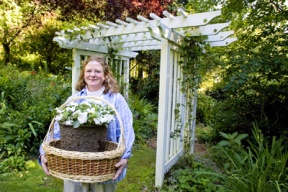Martha Pyne used gut instinct and hard work – all her own – to grow an eden.
When faced with a large property to landscape and maintain, most gardeners opt for help, whether it’s bringing in design consultants, hiring crews or just getting a neighborhood kid to mow the lawn.
Martha Pyne has done none of this. Over the course of 24 years in her Skinner Road home, she’s carved out a two-and-a-half acre oasis all on her own using a pick axe, basic scientific principles and her two hands.
“I have done 100 percent of the work,” Pyne said. “Every blade of grass, every wheelbarrow has my name on it.”
This weekend, Bainbridge in Bloom garden tour visitors can view the fruits of Pyne’s labor – or more accurately, the abundance of flowers, shrubs, ground covers and trees that constitute her home-grown oasis.
Pyne’s design sensibility lies in creating color combinations that please her – some friends ask if she’s colorblind – and putting plants in places where they’ll fit. While she can’t remember the Latin names of most plants, she possesses “laser accuracy as to who gave me what,” whether it’s “Rosemary’s astilbes” or “Mike’s rhodies.”
Thus her garden is one of remembrances, including the pear and the apple tree planted when each of her daughters was born, and the two partial shade beds in remembrance of her mother and father.
In that familial spirit, Pyne also finds a place for any orphaned plant she comes across. Word of mouth and years in the Bainbridge gardening community have turned her into the “plant mother.”
When people decide to make big changes to their gardens, she’s at the ready to salvage treasures that would otherwise end life in the compost bin.
“Gardeners inherently want to have homes for their babies,” she said.
Between others’ offerings and an eagle eye for opportunity, Pyne operates on an admirably small budget.
During a severe and lengthy freeze in the winter of 1990, Pyne stopped into Bainbridge Gardens for a plant fix and noticed a group of trees that ostensibly hadn’t survived the cold. She gently scratched the bark and after determining that there was some life yet in these chipper-bound “poles in a pot,” she asked owner Junkoh Harui if she could have them.
Pyne said Harui thought she was crazy but sold her the 32 trees, some originally priced in the hundreds, for a dollar each.
She planted, pruned and nursed. Today, the collection of 15- and 20-foot beauties, including Lebanese cypresses, Japanese maples and dogwoods, form the structural backdrop of her garden.
She left the original price tags on.
If Pyne applies healthy doses of impulse to her garden, she also takes cues from her scientific background. Thirty years in the field of auto-immune research have given her a sense of plant and weed biology.
So she’s not afraid to snip a bloom, even during a plant’s flowering prime, because she knows doing so will encourage more. And she knows that if you put a cutting into great soil, it’ll take root, the way a pile of laurel clippings did when she stuck them in the ground at the back of her property. She got a 300-foot hedge out of it.
She uses no chemical fertilizers or pesticides and attributes her great soil to gourmet horse manure that she buys for $10 per truck load.
Conventional gardening wisdom says horse manure is notoriously full of weed seed. But Pyne only gets plops from “fancy horses” who over-winter in a barn while living large on horse chow.
Since they’re not eating outside, they’re not eating weeds. And when they go back to pasture in the spring, Pyne stops buying. Her garden is virtually weed-free.
When Pyne first built her house, the yard was surrounded by dense woods.
Following the lines created by natural obstacles like rocks, stumps and fern banks, she pick-axed a woodland path around the circumference of her central lawn and sun beds. Swaths of hydrangeas and fuschia flank the path along with carpets of pulmonaria and clover.
As Pyne walks through, she recounts the stories and strategies that accompany each bed and plant.
The only time she expresses displeasure is near a patch of hostas that the deer have de-foliated; she philosophically laments the fact that her garden is “a diner for deer.”
“When people come, they’re going to be appalled at the celery sticks,” she said. “But that’s just the way it is.”
***************
Bloom time
The 19th annual Bainbridge in Bloom Garden Tour, benefiting the Bainbridge Island Arts and Humanities Council, runs July 12-15 starting with workshops on Thursday, Patron Day on Friday and a tour of five local gardens Saturday and Sunday. Dan Hinkley will close the weekend with a presentation on drought-tolerant plants. The tour will also feature a festival hub with food, crafts and plants for sale. For tickets, schedules and information on parking and shuttles, see www.gardentour.info or call 842-7901.


